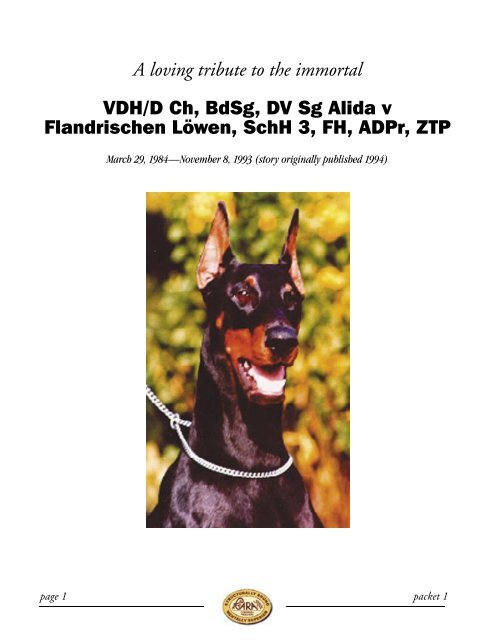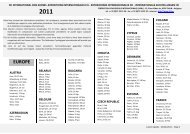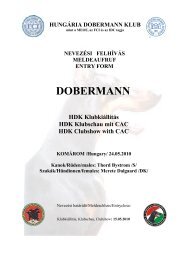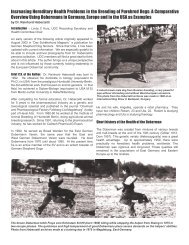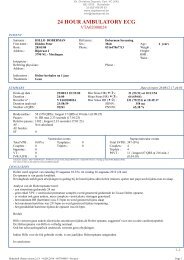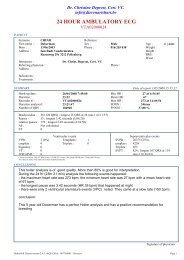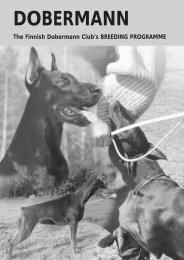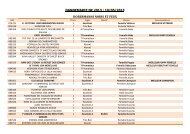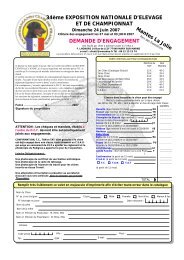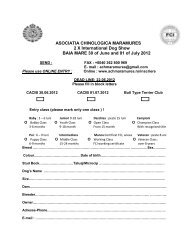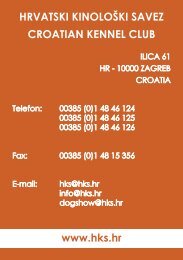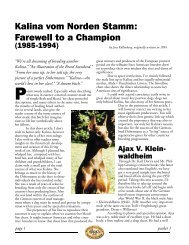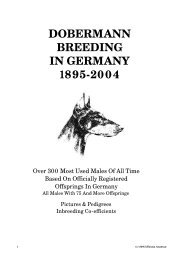Alida v.Flandrischen Loewen - Dobermann Review
Alida v.Flandrischen Loewen - Dobermann Review
Alida v.Flandrischen Loewen - Dobermann Review
- No tags were found...
You also want an ePaper? Increase the reach of your titles
YUMPU automatically turns print PDFs into web optimized ePapers that Google loves.
A loving tribute to the immortalVDH/D Ch, BdSg, DV Sg <strong>Alida</strong> v<strong>Flandrischen</strong> Löwen, SchH 3, FH, ADPr, ZTPMarch 29, 1984—November 8, 1993 (story originally published 1994)page 1 packet 1
Vale <strong>Alida</strong> v<strong>Flandrischen</strong> LöwenBy Alison KollenbergAeulogy in honor of <strong>Alida</strong> is not only timely, butrichly deserved, because here was a bitch whosegenetic influence is enormous, often equaling andat times surpassing that of prominent stud dogs. For abitch, whose number of offspring is limited by the natureof her gender, that is no mean feat. Apart from her daughter(Kalina vom Norden Stamm), the amazing depth andbreadth of her influence world-wide could be said to beunrivalled by any bitch since the post war period.Consider that her children, grandchildren, andgreat-grandchildren are to be found in more than 27<strong>Dobermann</strong> breedinglands. Amongst these aremany highly acclaimedand decorated animals.The numerous Siegers,Specialty Winners,National Champions,Best-In-Show winners,conformation and workingchampions and breedingchampions makesan impressive list whenviewed on paper.Bred in the purpleherself, <strong>Alida</strong>’s excellentphenotype and genotypewas able to consistentlyproduce animals that, inturn, themselves provedto be exceptional producers.This is borne out bythe number of countrieswhose leading stud dogsand bitches have had an obvious impact on the developmentand direction of the breed in these lands and aredirectly related to <strong>Alida</strong> in the immediate pedigree.<strong>Alida</strong> herself was no “soap bubble.” She came outof the key bloodline responsible for producing the greatmajority of Germany’s <strong>Dobermann</strong>s of significance.The same bloodlines, in fact, from whence sprang theUSA’s most significant producers of the early post-warperiod (see the Bloodline chart later in this article).<strong>Alida</strong>’s pedigree also combined in the immediate backgroundthe country’s two most acclaimed stud dogs oftheir era, successfully combining the “rough and thesmooth.” Namely the rough, robust power of the Siegerdog, Bronco v Zenn, SchH III, and the smooth, elegantnobility of the Sieger dog, Guy’s Hilo V. Norden Stamm,SchH III. <strong>Alida</strong> had 4 Bundessieger (German NationalChampions) in her first and second generations alone!Her mother, the Bronco daughter Alexa v. Heiderhof,SchH III, was also a Bundessieger, as was her sire, theHilo son, Ali v. Langenhorst, SchH III. <strong>Alida</strong> was, infact, a worthy royal daughter of a most royal house.Since being exported to the USA, <strong>Alida</strong>’s storyis best told by those more closely involved with her inthat country. But her life story in Germany before thistime has passed on great wealth to the breed there andelsewhere, and needs telling if only for that reason alone.Her story had a remarkable beginning to what was toprove a remarkable life.<strong>Alida</strong>’s mother, Alexa, was the smallest and leastimposing in her litter and, therefore, the last to be sold.But she blossomed like the proverbial Ugly Duckling,and by 1982 had becomeGermany’s top winningshow dog and alsoBundessieger at the earlyage of 18 months (anachievement later matchedby her daughter <strong>Alida</strong>, and<strong>Alida</strong>’s daughter Kalinaafter her). Alexa’s siblingswere also successful, withsix of them becomingchampions with SchH IIItitles. This was a highlyfertile family, as later seenby the large litters sheand her offspring alwaysproduced. It was notuncommon for them tohave litters of anywherefrom 10 to 18 puppies.<strong>Alida</strong> v <strong>Flandrischen</strong> LöwenTaking into account that<strong>Alida</strong>’s family was alsoknown for its longevity, itcould be deduced that these factors, together with theirhigh individual prepotency, were key factors behind herfamily’s broad genetic sphere of influence.Around this time my husband, Jens Kollenberg,came on the scene. We had just returned to Germanyand were looking for a foundation bitch to take upwhere he had left off some years earlier. Reading theDV Club’s show critique books, it became apparentthat Alexa possessed those qualities he was looking for.A meeting was arranged to see Alexa with the view ofbuying or leasing her from her owner, Albert Rochtus.Neither proved possible, but my husband and her ownerpage 2 packet 1
did come to an unorthodox arrangement whereby herowner would breed her to the male of Jens’ choice, and wewould buy all the bitches in the litter. It was Alexa’s owner’sfirst litter, the “A” litter, and there were five bitches inall: Anka, Anja, Amida, Azura, and <strong>Alida</strong>. We ran all thepuppies on till 3 months of age, and then made our finalpicks, retaining the two pearls (<strong>Alida</strong> and Anka). Azurawent to Australia and died of milk fever while raisingher second litter. Amida went to the German Chief ofJudges Ottmar Vogel, and was later repurchased by usand finally exported to Adlercrest Kennels in the USA,where she went on to form a smalldynasty of her own internationally.Anja was sold locally, was never bred,and remains today with her family inElmshorn, Germany.But without a doubt, <strong>Alida</strong>and Anka were the stars. Bothbitches placed at the top of themajor Sieger shows, easily earningtheir conformation and workingchampionships. Through the breedingbox, they repeatedly proved tobe bitches of great genetic powers.These bitches weren’t the only starsin the litter, as the males Atlas,Aristo (exp. Norway) and Arminalso proved to be above averageshow dogs and producers. I personallyknow of at least five championsin this litter.<strong>Alida</strong> was an extroverted andflashy puppy. From both her parentsshe inherited the good shoulderand upper arm and strong bone andsubstance so necessary in any broodbitch worth its salt. From her sire came the rich color,strong head and way above-average fighting spirit andprey drive. These points weren’t lacking in Alexa either,but specifically from her mother <strong>Alida</strong> inherited the longneck that seemed to go on forever and her wonderfuldryness and style. More compact and muscular overallthough, <strong>Alida</strong> was a fast, dynamic bitch to work andshow, easily earning her championship, SchH III andFH titles. She also became Bundessieger and DV Sieger(German Club Specialty Winner) shortly before beingexported to the USA.It is worth mentioning here that German <strong>Dobermann</strong>sare practically unique amongst the large workingbreeds in that they have as often as not succeeded incombining their show and working champions in oneand the same dog.When it came time to breed <strong>Alida</strong>, Jens Kollenburgfound a male whose own individual qualitieswould not only compliment hers, but bring fresh impetusto the offspring through his own outstanding inheritance.Our “K” litter vom Norden Stamm, <strong>Alida</strong>’s firstlitter by the Sieger dog, Ebo v.d. Groote Maat, SchH I,has gone down in the history books as one of the mostimportant litters bred in Germany in that decade. Therewere 11 puppies. Most were exported to other lands andfive became champions. Of these, without a doubt themost famous is Kalina v. Norden Stamm, SchH III,a bitch whose formidable qualities in both the workingand show arenas have earned her high praise fromhigh places in several languages.Kalina, together with her fullsister in blood, Mia v. NordenStamm, by Ebo out of <strong>Alida</strong>’ssister Anka, can take their placeamongst the most titled animalsin the history of the <strong>Dobermann</strong>breed, in fact.There were nine bitches in the“K” litter, and all were pre-sold tobreeders world-wide who wishedto capitalize on their geneticbackground. The two males inthis litter, Ken and Kandy, wentinto domestic “working dog”homes, whose owners unfortunatelyshowed no interestedtalent in promoting them at stud.Therefore, it has been throughits female, or “mother line,” thatthis family has continued itswidespread influence on breed<strong>Alida</strong> and daughter Kalina development. Only Kalina,Kastra, and Kassandra remainedin Germany, with the twoformer later proving to be the most prepotent in successfullyreproducing their inheritance. The sisters Kamilla,Karma, Kitopakita, Karamella, Katrina, and Kira wentfar abroad to Sweden, Norway, Japan, the USA andAustralia (later re-directed to the USA) respectively. Itwas consistently found that their greatest successes weremost pronounced when these bitches were bred to thehighest quality males who could also fundamentallysupport their blood. The long list of Champions, Siegers,and Specialty Winners that have emerged from suchcombinations also supports this conclusion.It was near Christmas when <strong>Alida</strong> whelped us herfirst litter, and around that time my husband was inNew York at a Westminster show, on the invitation ofAmerican breeder/judge Marilyn Meshirer, to speak ata judges training seminar held in conjunction with theshow. It was here that Jens first met Ray Carlisle, a past-President of the DPCA and to become <strong>Alida</strong>’s futurepage 3 packet 1
owner and life-long friend. It was an explosive firstmeeting, with these two strong-minded men comparingbreeding systems that, on first evaluation, seemed tohave little in common but the name of the breed. Whenthe dust had settled though, it became soon apparentthat both men really held the same ideals in a dog. Hiscuriosity piqued, Ray made a reciprocal flight to Hamburgin Northern Germany to meet our current youngSiegerin, <strong>Alida</strong>.Hers was a vivacious, vital personality and herenormous youthful eye appeal made an immediateimpact on Ray. Although such high profile animalsare rarely offered for sale, in the spirit of internationalcooperation my husband agreed to part with <strong>Alida</strong>. Sixmonths later she found herself a resident of the USA,where her life story continued to unfold like a flower inblossom and whose details are best relayed to readers bythose in first-hand contact with her during that period.To sum it up, it might interest American readers toknow that at the time of her importation, <strong>Alida</strong> was thefirst genuine German Sieger dog since Jesse v.d. Sonnenhoheto be exported to the USA. A significant differencebetween <strong>Alida</strong> and Jesse was that <strong>Alida</strong> was the firstSiegerin imported by an American to have also passedthe working trials and German ZTP (Fit for Breedingtest). <strong>Alida</strong> could be said to have something very muchin common with Jesse v.d. Sonnenhohe…her pedigreecarries 445 crosses to Jesse!Conformation, working, and reproductive championsdirectly descended from <strong>Alida</strong> can be found onevery continent today. For example, inside the USA onerecent conformation champion descended from <strong>Alida</strong> isher grandson, American & Canadian Ch. Cara’s Talon,Am/Can CD, BH, CGC, VCX, ROM. Talon wasthe 1992 DPCA National Reserve Winners Dog andnotably also bred by Ray Carlisle. No doubt it was withfeelings of great satisfaction for Ray to see his innovativevision pay off in just one of many tangible rewards.I have hesitated to list the names and homelands of<strong>Alida</strong>’s hundreds of other highly successful descendants.I had started a list, but it grew out of all proportionto what could be accommodated in an article such asthis, and at the same time I feared I would omit manyof those animals that I cannot be personally aware of.With this in mind I have instead chosen not to nameindividuals at all. They know who they are, whereverthey be!One thing is certain…there can hardly be anyother <strong>Dobermann</strong> bitch in post-war breed history thatcan match <strong>Alida</strong>’s profound impact on the internationaldevelopment of this breed. Therefore, let us write up hername in words of fire for all posterity to appreciate theenormous breadth and depth of her individual contributionto the breed. Irrespective of nationalities or origins,by any standards she can stand proudly amongst thosetruly great <strong>Dobermann</strong>s recorded in breed history.Memories of a truefriendBy Ray CarlisleIfirst heard about <strong>Alida</strong> from Jens Kollenberg when hewas in America for the Westminster Show in 1986.Jens was saying how much better he thought the bitchhe had in Germany was than anything he had seenhere in America. Of course, being the kind of arrogantindividual that he is, with the pride and confidence hehas in himself (and in his dogs), he and I did not hit itoff too well. So we ended up in a little bit of controversyright off the bat.But Jens’ confidence and how good he thought<strong>Alida</strong> was took my curiosity to the max…I flew to Germanyto see her and her get. What was really convincingwas seeing her and her kids (who were about 6 monthsold at the time, sired by Int/Ger/Span Ch Ebo v.d.Groote Maat, SchH 1). They were without a doubt themost impressive pups I had ever seen; even though theywere in a strange place, they were outgoing and unconcerned,and beautiful. <strong>Alida</strong> herself was just breathtaking,with an exquisite head and expression and an airabout her…she strutted as she walked. I instantly fell inlove with her.Every task Jens or I asked of her she did, and didwell. She was very much in tune to commands, andwhen I called upon her she responded instantly.I started trying to negotiate to buy her; she reallywasn’t for sale, so it was quite a struggle. At that timeshe only had a SchH 1 degree, and had just goneBundessiegerin (meaning she was the best Dobermanbitch in Germany in 1985).To make a long story short, I worked out a dealwhere I would purchase <strong>Alida</strong>, but only after she hada SchH III title. Needless to say, she earned her SchHIII and an FH six to eight weeks later…which is easy tobelieve because she was that type of dog, quick to learnand a very sensitive and willing worker.Living with <strong>Alida</strong> was a great pleasure, especiallywatching her work and perform. I think anyone whoever saw her would say she was an exciting dog to watch.But living with her was really the big insight into her;she was the easiest dog to live with I had ever beenaround. She was extremely protective, but also verypredictable. She would always let you know how she felt.page 4 packet 1
She was tough but controlled. She gave you the confidencethat she could literally do anything you asked herto do, and that she would want to do it. She was what Iwould have to call a perfect house dog…very protectiveof the house (and very vocal!), quiet when you askedher to be quiet, going to her own spot to lay down andbehave herself. She wasn’t a pain in the neck.On the other side of the coin, I could leave thehouse with the greatest of confidence that there wasn’t asoul who was going to come through that door without<strong>Alida</strong> knowing it and without her voicing a heavy objectionuntil someone told her it was OK. Once you toldher it was OK it was, and there weren’t any arguments.But if someone tried to sneak in or threaten, or had anybad motive in mind, there isn’t any doubt she would takethem on…and she woulddo it instantly, withouthesitation. Even so, mykids ran in and out of thehouse with their friends,and my grandchildren werealways running around thehouse (just like any normalhousehold), and <strong>Alida</strong> hadthe ability to discriminate.She was extremely trustworthy.The only time therewas ever any problem waswhen she had puppies;then, the only person thatwas always OK was me.When I was home, I wasin charge. That’s the way<strong>Alida</strong> was. I was the bossand she knew it, and whenI was home it was fine. But if I was gone you had to bevery conscious of her, and cautious because she was veryprotective of her puppies.<strong>Alida</strong> represented the result of generations of selectivebreeding for both physical beauty and excellentmentality. Now, she was not perfect. But she had stronginstincts and drives and passed those qualities (togetherwith physical beauty) to her children and grandchildren.While most dogs have pieces of what they should havementally, living with <strong>Alida</strong> was really rewarding becauseall the pieces fit together. She had high drive yet wasalways controlled, not at all wacky to live with. I lovedand enjoyed the Dobermans I had before <strong>Alida</strong>, theywere unique and special in their own ways. But neverbefore had I experienced a “Total Doberman” and thefact that it really is possible to have multiple layers ofdepth in a pedigree. This makes it possible to producedogs that can do it all and are a joy to live with. That’swhat Dobermans are all about!Another reason I wanted European bloodlines wasthat I had just gone through earning a SchH I (and failinga couple of times with a SchH II) with Cara’s Sonof a Butch (Chip) and I had lost him to a heart attack at5 years old. Chip was my 5th straight Doberman to diefrom cardiomyopathy, and I felt an obligation that, if Ireally was a true Doberman person, I should do somethingabout it instead of giving lip service. I felt the bestalternative was to go to Europe and get a very healthy andbeautiful dog, well trained, and bring it here to begin mybreeding program again from scratch. Thus, <strong>Alida</strong> wasthe chosen one. I couldn’t have made a better choice.<strong>Alida</strong> was, without a doubt, one of the breed’sgreatest of all time. I don’t say that because she was myclosest friend, but becauseof everything she hasdone and everything shestands for. She representsa long line of producers:her mother, herself, hersons and daughters andnow her grandchildren.It’s something that’s in thegenes that stamps their getone or two notches aboveeveryone else around them.And she not only producedtremendous quality,but quantity as well(very large, healthy litters).Her offspring are successfullyrepresented on everyCh Elecktra’s The Windwalkercontinent in 28 countries,as show dogs, workingdogs, and outstandingproducers. She was only bred 3 times, yet her impact onthe breed has been tremendous. The ability to producequality in quantity…that’s depth of pedigree.I bought <strong>Alida</strong> for health reasons and for the sportof Schutzhund. I wanted a dog I could compete withbecause I am not a very good trainer; <strong>Alida</strong> made melook like I was excellent. I could walk out on the sportfield with her, and she gave me that 100-point attention.She would walk and strut with her neck curled aroundmy leg, looking up into my eyes saying, “Dad, let’s go,what do you want next? Hurry, hurry, hurry, I’m ready!”With that kind of bouncy attitude, you never saw herwith her tail down and her ears tucked back. Her earswere always up and she had fire in her eyes, and hertail was straight up because she enjoyed it and she washaving fun.Jens delivered her to me in 1986 at the DPCANational in Denver, Colorado. She earned her SchH III,page 5 packet 1
and I beamed with pride; she and Jens looked very goodtogether. Even though I knew I was nowhere near hisstandard as a handler or trainer, I was looking forwardto working with <strong>Alida</strong>.So I went home with my dog and began to workwith her, and we entered our first Schutzhund trial inPennsylvania. Believe it or not we went High in Trial…and nobody could take their eyes off her.<strong>Alida</strong> was such an outstanding performer that to beworking with and training with this dog was an experiencenobody could ever explain. She just begged me towork with her. She hadsuch excitement, suchenthusiasm. <strong>Alida</strong> wouldpull me on a bicycle, that’show she kept in condition.We would go for milesevery day. She was withouta doubt the strongest bitchI have ever seen and couldpull me 5 miles non-stopon a bicycle without myhaving to pedal; if you don’tthink that’s a lot of work,go out and try to road worka dog for 5 miles, muchless have one pull you on abicycle for 5 miles.By her mannerismsand personality, <strong>Alida</strong>built confidence in meand anyone who saw herperform, because she wassuch a spirited performer. Her protection skills and herpresentations were really animated and fast. She was,without a question, extremely intense; I guess that wouldbe the best word to describe <strong>Alida</strong>, intense.<strong>Alida</strong> was a playful dog who enjoyed running andplaying, having a grand old time. When I would goplaces, I would bring her too. I used to bring her withme to the office, and she’d make friends with everyone,then just lie down by my side and never be in the way.She would go with me to the job sites (I own a constructioncompany), run around and make friends with theguys at the site. She was very protective of the car, soany time I’d leave her in the car she would certainly leteveryone know to stay away from the car. Yet she wasthe kind of dog that made friends with everyone anddrew attention to herself. She just commanded attentionand respect.<strong>Alida</strong> was very strong in character and had veryhigh drives. Her prey drive was extremely high, and herguarding work was just spectacular. She wasn’t a reallyhard dog; you couldn’t go banging around on <strong>Alida</strong>. Shewas much too sensitive for that. I call it intelligence, notjust sensitivity: sensitive to the handler, and intelligentto avoid the pain. This type of intelligence, this type ofdrive personifies the type of dog she was.I bred <strong>Alida</strong> twice to American stud dogs (Ch.Electra’s the Wind Walker and Ch Akela’s the Vindicator)to blend together the best of the best, offeringthe American public a high quality alternative. Unfortunately,most American breeders don’t realize whatthey’re missing because they have never had what <strong>Alida</strong>offered. You don’t miss what you never had.<strong>Alida</strong> produced twolitters for me, and itwas really educational.I’d watch her teach herpuppies how to play andsocialize with each other,how to hunt and be competitive…butshe neverallowed them to fight.She taught them to usetheir noses to find foodand would hide their toys,forcing them to use theirnoses to find them. It wasa learning game.I have her grandchildrenaround me all thetime, and they re allspecial to me. But <strong>Alida</strong>Ch Akela’s The Vindicatorwas my “once in a lifetimedog,” my best friend andteacher. She was the dogthat really taught me about European stock, the result ofgenerations of breeding for working ability, beauty, andconformation, what depth of pedigree really means. It’stotally different from breeding for generations only forphysical beauty. She was a dog who “walked the walkand talked the talk,” as the saying goes; <strong>Alida</strong> lived herlife as an example of excellence.She had such dignity and, even during her lastdays, she loved life and wanted to live. I made a gravemistake. I let her suffer over a weekend because I justdidn’t want to give her up. The mistake I made washaving a tumor removed from her breast; 30 dayslater she was dead. I wish now that I had it to do overagain…maybe she would have lived longer.I sorely miss <strong>Alida</strong>. She’s buried underneath theold oak tree on my property in Washingtonville, NY,where she loved to run and hunt and play. I’m sure thatif there’s a heaven for dogs, <strong>Alida</strong> is there.<strong>Alida</strong>’s get include 12 champions, 9 schutzhundtitles, 4 CDs and 1 CDX so far…page 6 packet 1
Litter #1, whelped in Germany, was sired byGerman Sieger Ebo v.d. Groote Maat, SchH 1, and produced4 champions and 6 schutzhund titled get:Int/Ger Ch Kalina v Norden Stamm, SchH 3Swe Ch Kamil v Norden Stamm, SchH1Karamella v Norden Stamm (major pointed inUS and Germany)Swe Ch Karma v Norden Stamm, SchH 3(multi BIS winner, avalanche dog)Ger Ch Kassandra v Norden Stamm, SchH 3Kastra v Norden Stamm, SchH 3Ken v Norden Stamm, SchH 1Litter #2, sired by Ch Electra’s the Wind Walker,produced 5 champions, 2 Schutzhund titled, and 4 CDget:VDH Ch Rotkappchen v.d. Cara, SchH 3, ZTPAm Braz Ch Cara’s Willing and Able (#1 dog,all breeds, Brazil, 1990)Ch Cara’s Irish Dancer N Romancer, CD,ROMCh Cara’s I’m the Gambler, WAC, TT, CGCCan Ch Cara’s WindchimeCara’s Caution Highly Flammable, SchH 2,WAC, BH, CDCara’s Quest v Justamere, CDSKC Ch Mirabel Leadin the Wind v Cara, CDLitter #3, sired by Ch Akela’s the Vindicator, hasproduced 2 champions, 1 Schutzhund titled and oneCDX titled get so far:Ch Cara’s Black Rose ChilkatCh Cara’s Forget Me NotCara’s On the Richter Scale, SchH 1, BH,CGC, TD1Cara’s Valar Lothlorien, CDXEarly alidaBy Luci Newsomn July 1984 my husband and I had to move from ourInative Texas to Weisbaden, Germany at the requestof the U.S. Air Force. Having been a member of theDPCA chapter club, I immediately began looking for away to contact the <strong>Dobermann</strong> Verein. As luck wouldhave it, I had seen an ad for a German dog in a DobermanQuarterly shortly before leaving the States; it wasan ad on Guy’s Hilo von Norden Stamm and h ad thebreeder’s name and phone number in Germany, so I wasable to call Jens and Alison Kollenberg within a monthof arriving in Deutschland. They were kind enough toconnect me with some local people and maintained afriendly phone relationship with me for quite a whilebefore we actually got to meet in person.The Kollenbergs invited me to see the two puppiesthey had decided to keep from a litter they’d recentlywhelped…and my first look at <strong>Alida</strong> and her littermateAnka was really my first look at the best of German<strong>Dobermann</strong>s. We went to a local specialty, where thejudge German Menke gave <strong>Alida</strong> her first CAC towardher German championship.I desperately wanted <strong>Alida</strong> for myself, but Jens andAlison weren’t ready to decide between anka and herand (unfortunately for me) they wished to keep <strong>Alida</strong> toshow and breed.Several months later, we went to San Antonio fora visit and I brought the photos I’d taken at dog showsthat year to show Frank Grover and let him see whatI’d been looking at in the German shows. He singledout <strong>Alida</strong>’s picture and said, “I like this one very much.”Neither of us knew then that he had picked out the nextBundessiegerin, and in October I was able to meet upwith the Kollenburgs and see <strong>Alida</strong> shown at her finestmoment. Being more than a little tenacious, I asked theKollenbergs to put me on a list for <strong>Alida</strong>’s first litter.Then we all (including <strong>Alida</strong>) went to dinner at thehotel near the Westfallen Halle…when the maitre ‘drealized <strong>Alida</strong> was the <strong>Dobermann</strong> Bundessiegerin, heimmediately sent a waiter for her own steak and napkinon the floor beneath our table!Two months later, <strong>Alida</strong> presented her breeders with11 beautiful puppies, her famous “K” litter. I was thinkingI’d be bringing a male home to the States, but fateintervened and I share my home today with Kalina andKarmella. I still regret not being able to own <strong>Alida</strong>, buthave been very happy with all that she has passed on toher children and grandchildren. If I never make much ofmy kennel in the <strong>Dobermann</strong> world, it won’t be for lackof some of the finest quality Dobermans ever bred.I am very lucky to have met the Kollenbergs, andluckier still to have two of <strong>Alida</strong>’s first offspring. WhenI remember that first year in Germany, it will alwaysbring back the memory of <strong>Alida</strong> too.<strong>Alida</strong>By Leslie HallRay Carlisle may have had an inkling as to whatlay ahead when <strong>Alida</strong> arrived in the U.S., thoughI doubt he knew the depth of this future. He hadacquired quite a legacy, and an enormous responsibilityto those that sent her and to her own potential.<strong>Alida</strong> was lovely to look at, calm and securepage 7 packet 1
mentally, and she quickly settled into Ray’s home andfamily. When she was to be bred to Ch Electra’s theWind Walker, I was asked to be her travel companion(and in my mind, her bodyguard!). Ray had given medetailed instructions, and I was a little concerned withthe task ahead of me. This was <strong>Alida</strong>, a schutzhhundtrained German-speaking European champion; Raywanted me to toss the ball with her, play with her, andstay with her. Right, take a valuable bitch that isn’t mineto a park in California and play ball with her. Not!My apprehensions were unnecessary.<strong>Alida</strong> and I spent two weeks in California. Wehung out, walked, went to dog shows and ate at BurgerKing every morning. We went sight-seeing together,and eventually played ball (off leash) in many beautifulplaces. She protected me fiercely at a convenience storewhere a robbery had just occurred; she never said a wordor raised a hair unless there was a real threat.She was the perfect Doberman in my mind, idealtemperament, sensible, stable, smart, fun, tough, loving,silly, thoughtful…and I came to wish she were mine.Through the years, she continued to prove my feelingsabout her. She taught Ray a lot, helping him grow indirections he might not have wandered without her. <strong>Alida</strong>taught everyone that met her something of what a Dobermancan be. Her get are worldwide sensations, and hergrandchildren are continuing in the same footsteps.The Doberman is much richer for having had<strong>Alida</strong> among its ranks, and Ray was very wise for havingbeen able to fulfill her potential. Perhaps he did knowwhat lay ahead when <strong>Alida</strong> arrived; he was very, verylucky to have had her as his best friend.Memories to last alifetimeBy Janice Myersremember the first time I met <strong>Alida</strong> as though it wasIyesterday. It was at the 1987 DPCA National in Somerset,New Jersey.I recall my comment to Ray at the time: “She iseverything I thought she would be, and more.” <strong>Alida</strong>had such a presence about her, she demanded attention.I had already fallen in love with her from herphotograph in the Doberman Quarterly for her litterannouncement.That same day Gambler, only 8 weeks old, sat onthe grass ringside and watched his mother <strong>Alida</strong> competein Schutzhund 3.<strong>Alida</strong> possessed an inner being that was trulyunexplainable; to me, her eyes offered all means of communication,her spirit and light-heartedness along withher desire to please made her outstanding. I have so manywarm and wonderful thoughts I will cherish a lifetime.I loved to watch her work. She made me laughevery time Ray would give her the command to finishfrom a recall; I could hear the grass move beneath herbottom as she eagerly placed herself by his side, thenlooked up to him for his approval.She has a place in my heart where she remains eachday, where all I have to do is call upon those memoriesand she brings a smile to my face. I will always see herrunning and carrying her tennis ball with a burningdesire to please, ready to work at a moment’s notice.It has been both a privilege and an honor to haveknown a Doberman like <strong>Alida</strong>, for a dog like her onlycomes along once in a lifetime and I thank God shecame into mine.It is very hard when one loses a Doberman, andespecially one that has had such an impact upon thebreed, one that was truly a devoted friend and companionto her owner.I will miss you my friend, and for all the wonderfulmemories I have it will help to ease the pain of yourloss…but we all must remember her death is not anend, for through her she leaves a legacy that will carryon in her name for future generations to come, here andaround the world.<strong>Alida</strong> was the totaldobermanBy Bonnie WittrockWhen I first saw <strong>Alida</strong>, she was playing with a manout in the field at the 1986 DPCA National inDenver, Colorado. I had no idea who the dog was, herbackground, or who the man was playing ball with her.I only knew this was one of the prettiest bitches I hadever seen in the 20+ years I had been breeding, training,and showing Dobermans.I stood and watched her for the longest time; therewas something very special about this bitch, she had amagnetic quality that made me look at her. Her animationand drive were exceptional.Her rust markings werea dark mahogany red color, and her black was the blackestblack you would ever see. I had been working on myown breeding program for 20+ years, but this bitch hadsomething I wanted…and for the first time I was lookingat a dog that made me want one just like it.At that time I was very pro-American dogs;even though I worked the sport of Schutzhund, I feltthe problems we were having in the sport was not thepage 8 packet 1
Doberman breed but the lack of knowledge on how towork a Doberman. I walked out on the field and spoketo the man who was playing with this exceptional bitch.He introduced himself as Jens Kollenburg, and wenton to tell me how this was German Ch <strong>Alida</strong> v <strong>Flandrischen</strong>Lowen, SchH 3, the first German Siegerinto come to the United States in 50 years. He told mehow a man by the name of Ray Carlisle had purchasedher for his breeding program and to work in the sport.I couldn’t believe my years. This wonderfully beautifulbitch was also a SchH 3…I must be dreaming! AGerman dog you could enjoy looking at!Starting that day, my ideals for my breeding programchanged, and they continued to change when Isaw <strong>Alida</strong> work in the Schutzhund trial a few days later.She was magnificent. I started to formulate a whole newidea of what the ideal Doberman and Total Dobermanmeant to me. This one bitch put my thinking processin overdrive, and I was re-evaluating everything thatI had come to learn to be true about the Doberman,it’s working abilities, and what my goal were to befrom that point on. I thought I was firm in my beliefs,but this single bitch changed my mind in one briefencounter. How could this be? I’m not a wishy-washythinker…once I make up my mind, it takes overwhelminginformation to change it. <strong>Alida</strong> changed my mindwithout a word ever being said.This encounter prompted me to purchase a bitchpuppy from the Kollenberg’s “M” litter (Morgan vNorden Stamm, SchH 3) , and now I own a grandson/great-grandson linebred on <strong>Alida</strong> (Am/Can Ch Cara’sTalon, Am/Can CD, BH, CDX, VCX, ROM), soon tobe schutzhund titled.<strong>Alida</strong> completely changed my breeding programand goals, and I’m not alone: she did more for theDoberman breed all over the world (changing mindsand upgrading breeding programs) than any other singleindividual I can think of. It will be many years beforewe see the full impact <strong>Alida</strong> has had on us all, and howmany lives she has changed simply by her presence andthe way she made it possible to compare.A great gratitude is owed to Ray Carlisle, forhaving the foresight to know the importance of thisbitch, and the knowledge to use her to benefit us all.<strong>Alida</strong> with littermate Amidapage 9 packet 1


